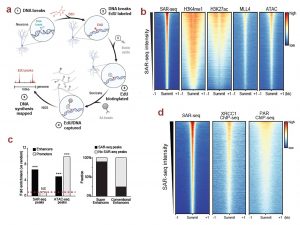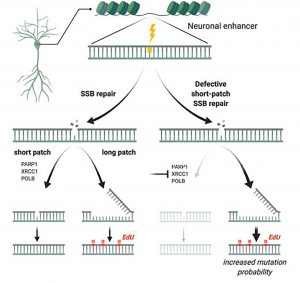Neuronal Enhancers are Hotspots For DNA Single-Strand Break Repair
Posted on: 6 January 2021
Preprint posted on 16 December 2020
Article now published in Nature at http://dx.doi.org/10.1038/s41586-021-03468-5
Endogenous DNA breaks at neuronal enhancers: novel links to neurodegeneration?
Selected by Giuseppina D'Alessandro, Sree Rama ChaitanyaCategories: cell biology
Background
Our cells have evolved various DNA repair pathways to deal with DNA lesions that constantly challenge the stability of our genome. Defects in DNA repair may lead to the development of cancer and immunological or neurological disorders (Jackson and Bartek, 2009). Repair of various DNA lesions, including single-strand breaks (SSBs), involves a gap-filling step, which incorporates one or several nucleotides into the damaged DNA using the undamaged DNA strand as a template.
Although neurons face different kinds of DNA damaging insults, defects in the SSB repair pathway seem to impact predominantly their function (Caldecott, 2008; Tubbs A, 2017). Indeed, hereditary mutations in genes encoding for SSB repair proteins, like XRCC1, are mainly associated with neurological phenotypes.
However, the extent and genome-wide distribution of SSB repair signatures in neurons are not clear. Thus, to gauge the genome-wide distribution of DNA repair signatures in post-mitotic neurons, the authors of this preprint developed a novel technique called SAR-seq and report that neurons accumulate SSBs in enhancer regions of the genome.
Key findings
- SAR-seq identifies sites of unscheduled DNA synthesis
Unscheduled DNA synthesis occurs during DNA repair to fill the gaps generated by excised or missing nucleotides (also known as gap filling). To map sites of DNA repair synthesis genome-wide, the authors developed a new method: synthesis-associated with repair sequencing (SAR-seq, fig 1a). For this purpose, they labelled iPSC-derived neurons (i3 neurons) with the thymidine analogue EdU, which is incorporated at the sites of DNA synthesis. The labelled DNA was biotinylated by click chemistry, sheared, and isolated for high-throughput sequencing. They identified >55,000 peaks at recurrent genomic locations around 200-2,000 bp in width, possibly reflecting clustered DNA repair loci. SAR peaks were also observed in rat neurons but not in other post-mitotic cells like G0-arrested pre-B cells or iPSC-derived skeletal muscles. Notably, SAR peaks were unaffected by inhibitors of the replicative DNA polymerases (α, δ, and ϵ), reinforcing that i3 neurons are not replicating and the SAR signal is from unscheduled DNA synthesis.

- Neuronal enhancers are hotspots for unscheduled DNA synthesis
They found that neuronal SAR peaks were enriched in intragenic regions and associated with expressed genes. In particular, ~50% of the top-5000 peaks harboured a transcription factor motif – ONECUT – that is known to promote chromatin accessibility. Furthermore, these peaks also coincided with ATAC-seq peaks (a readout of open chromatin), suggesting that an open chromatin structure may influence the extent of DNA synthesis. Intriguingly, a majority of SAR peaks were enriched at cis-regulating enhancer elements (rather than promoters), as measured by enhancer histone modifications (H3K4me1, H3K27ac) and Lysine Methyltransferase 2B (MLL4) (ChIP-seq, fig 1b). Adding, most of the SAR peaks occupied super-enhancers that are active in differentiated neurons (fig 1c). Gene Ontology (GO) analysis also revealed that genes containing SAR peaks were related to neuronal functions (like neuronal migration, development, axon formation, and synapse assembly).
- Neuronal DNA synthesis coincides with SSB and PARP activation loci
DNA double-strand breaks (DSBs) induced by Topoisomerase II (TOP2) can promote the expression of early response genes in neurons (Madabhushi, 2015). However, DNA synthesis associated with TOP2-induced lesions did not overlap with the SAR peaks observed in untreated neurons (reiterating that SSBs mostly occur in untreated i3 neurons). Additionally, no DSBs were detected in untreated neurons, as monitored by immunofluorescence for DSB markers or END-seq, a technique that maps DSBs (Canela, 2016).
Furthermore, they found that SAR peaks corresponded to sites of PARylation and XRCC1 recruitment, key events in SSB repair (assayed using ChIP-seq, fig 1d). In SSB repair either a single nucleotide or longer DNA patches are replaced respectively by DNA polymerase β (short-patch SSB) or DNA polymerase δ, ϵ or l (long-patch SSB). The authors observed that PARP1, XRCC1, or DNA polymerase β depletion increased SAR peaks, suggesting reliance on long-patch repair when the short-patch repair is challenged (fig 2).

Conclusion and perspective
In summary, this study reports that in human post-mitotic neurons, SSBs and unscheduled DNA synthesis occurs within enhancers. The presence of neurodegenerative phenotypes in patients with mutations in XRCC1 suggests a key role for short-patch SSB repair in neuronal viability (fig 2). The authors speculate that loss of XRCC1 function could lead to neuronal dysfunction by aberrant PARP1 activity or by the accumulation of mutations that could result in aberrant transcription and neurodegeneration.
Future work could reveal how different non-replicating cells deploy different DNA repair pathways and how endogenous DNA damage supports the normal physiology of different kinds of cells.
Acknowledgments: We are thankful to all the authors for their support and for taking the time to comment on the preLight.
References
- Caldecott, K. W. Single-strand break repair and genetic disease. Nat Rev Genet (2008).
- Canela, A.et al., DNA Breaks and End Resection Measured Genome-wide by End Sequencing, Mol Cell (2016).
- Jackson, S. P. & Bartek, J. The DNA-damage response in human biology and disease, Nature (2009).
- Madabhushi, R.et al., Activity-Induced DNA Breaks Govern the Expression of Neuronal Early-Response Genes, Cell (2015).
- Mellén M et al., 5-hydroxymethylcytosine accumulation in postmitotic neurons results in functional demethylation of expressed genes, Proc Natl Acad Sci U S A. (2017).
- Puc J,et al. Ligand-dependent enhancer activation regulated by topoisomerase-I activity, Cell (2015)
- Tubbs A, & Nussenzweig A. Endogenous DNA Damage as a Source of Genomic Instability in Cancer, Cell (2017).
doi: https://doi.org/10.1242/prelights.26737
Read preprintSign up to customise the site to your preferences and to receive alerts
Register hereAlso in the cell biology category:
Cell cycle-dependent mRNA localization in P-bodies
Mohammed JALLOH
Control of Inflammatory Response by Tissue Microenvironment
Roberto Amadio
Notch3 is a genetic modifier of NODAL signalling for patterning asymmetry during mouse heart looping
Bhaval Parmar
preLists in the cell biology category:
BSCB-Biochemical Society 2024 Cell Migration meeting
This preList features preprints that were discussed and presented during the BSCB-Biochemical Society 2024 Cell Migration meeting in Birmingham, UK in April 2024. Kindly put together by Sara Morais da Silva, Reviews Editor at Journal of Cell Science.
| List by | Reinier Prosee |
‘In preprints’ from Development 2022-2023
A list of the preprints featured in Development's 'In preprints' articles between 2022-2023
| List by | Alex Eve, Katherine Brown |
preLights peer support – preprints of interest
This is a preprint repository to organise the preprints and preLights covered through the 'preLights peer support' initiative.
| List by | preLights peer support |
The Society for Developmental Biology 82nd Annual Meeting
This preList is made up of the preprints discussed during the Society for Developmental Biology 82nd Annual Meeting that took place in Chicago in July 2023.
| List by | Joyce Yu, Katherine Brown |
CSHL 87th Symposium: Stem Cells
Preprints mentioned by speakers at the #CSHLsymp23
| List by | Alex Eve |
Journal of Cell Science meeting ‘Imaging Cell Dynamics’
This preList highlights the preprints discussed at the JCS meeting 'Imaging Cell Dynamics'. The meeting was held from 14 - 17 May 2023 in Lisbon, Portugal and was organised by Erika Holzbaur, Jennifer Lippincott-Schwartz, Rob Parton and Michael Way.
| List by | Helen Zenner |
9th International Symposium on the Biology of Vertebrate Sex Determination
This preList contains preprints discussed during the 9th International Symposium on the Biology of Vertebrate Sex Determination. This conference was held in Kona, Hawaii from April 17th to 21st 2023.
| List by | Martin Estermann |
Alumni picks – preLights 5th Birthday
This preList contains preprints that were picked and highlighted by preLights Alumni - an initiative that was set up to mark preLights 5th birthday. More entries will follow throughout February and March 2023.
| List by | Sergio Menchero et al. |
CellBio 2022 – An ASCB/EMBO Meeting
This preLists features preprints that were discussed and presented during the CellBio 2022 meeting in Washington, DC in December 2022.
| List by | Nadja Hümpfer et al. |
Fibroblasts
The advances in fibroblast biology preList explores the recent discoveries and preprints of the fibroblast world. Get ready to immerse yourself with this list created for fibroblasts aficionados and lovers, and beyond. Here, my goal is to include preprints of fibroblast biology, heterogeneity, fate, extracellular matrix, behavior, topography, single-cell atlases, spatial transcriptomics, and their matrix!
| List by | Osvaldo Contreras |
EMBL Synthetic Morphogenesis: From Gene Circuits to Tissue Architecture (2021)
A list of preprints mentioned at the #EESmorphoG virtual meeting in 2021.
| List by | Alex Eve |
FENS 2020
A collection of preprints presented during the virtual meeting of the Federation of European Neuroscience Societies (FENS) in 2020
| List by | Ana Dorrego-Rivas |
Planar Cell Polarity – PCP
This preList contains preprints about the latest findings on Planar Cell Polarity (PCP) in various model organisms at the molecular, cellular and tissue levels.
| List by | Ana Dorrego-Rivas |
BioMalPar XVI: Biology and Pathology of the Malaria Parasite
[under construction] Preprints presented at the (fully virtual) EMBL BioMalPar XVI, 17-18 May 2020 #emblmalaria
| List by | Dey Lab, Samantha Seah |
1
Cell Polarity
Recent research from the field of cell polarity is summarized in this list of preprints. It comprises of studies focusing on various forms of cell polarity ranging from epithelial polarity, planar cell polarity to front-to-rear polarity.
| List by | Yamini Ravichandran |
TAGC 2020
Preprints recently presented at the virtual Allied Genetics Conference, April 22-26, 2020. #TAGC20
| List by | Maiko Kitaoka et al. |
3D Gastruloids
A curated list of preprints related to Gastruloids (in vitro models of early development obtained by 3D aggregation of embryonic cells). Updated until July 2021.
| List by | Paul Gerald L. Sanchez and Stefano Vianello |
ECFG15 – Fungal biology
Preprints presented at 15th European Conference on Fungal Genetics 17-20 February 2020 Rome
| List by | Hiral Shah |
ASCB EMBO Annual Meeting 2019
A collection of preprints presented at the 2019 ASCB EMBO Meeting in Washington, DC (December 7-11)
| List by | Madhuja Samaddar et al. |
EMBL Seeing is Believing – Imaging the Molecular Processes of Life
Preprints discussed at the 2019 edition of Seeing is Believing, at EMBL Heidelberg from the 9th-12th October 2019
| List by | Dey Lab |
Autophagy
Preprints on autophagy and lysosomal degradation and its role in neurodegeneration and disease. Includes molecular mechanisms, upstream signalling and regulation as well as studies on pharmaceutical interventions to upregulate the process.
| List by | Sandra Malmgren Hill |
Lung Disease and Regeneration
This preprint list compiles highlights from the field of lung biology.
| List by | Rob Hynds |
Cellular metabolism
A curated list of preprints related to cellular metabolism at Biorxiv by Pablo Ranea Robles from the Prelights community. Special interest on lipid metabolism, peroxisomes and mitochondria.
| List by | Pablo Ranea Robles |
BSCB/BSDB Annual Meeting 2019
Preprints presented at the BSCB/BSDB Annual Meeting 2019
| List by | Dey Lab |
MitoList
This list of preprints is focused on work expanding our knowledge on mitochondria in any organism, tissue or cell type, from the normal biology to the pathology.
| List by | Sandra Franco Iborra |
Biophysical Society Annual Meeting 2019
Few of the preprints that were discussed in the recent BPS annual meeting at Baltimore, USA
| List by | Joseph Jose Thottacherry |
ASCB/EMBO Annual Meeting 2018
This list relates to preprints that were discussed at the recent ASCB conference.
| List by | Dey Lab, Amanda Haage |











 (No Ratings Yet)
(No Ratings Yet)